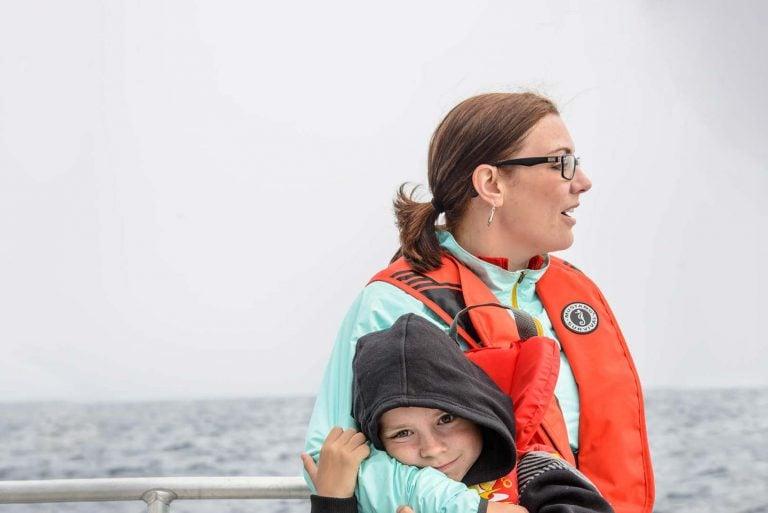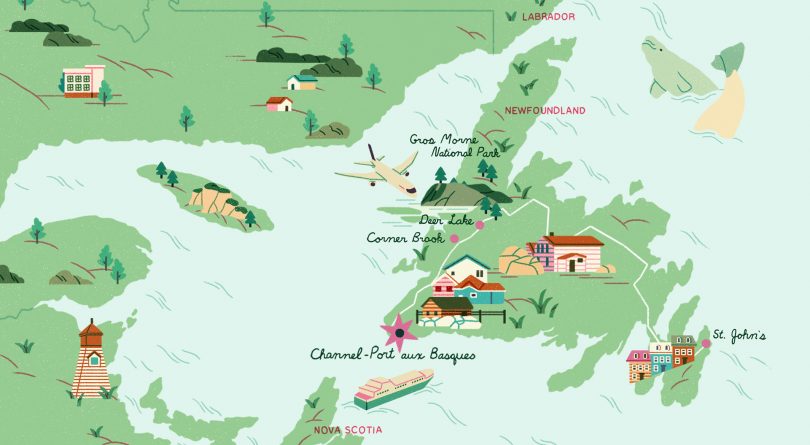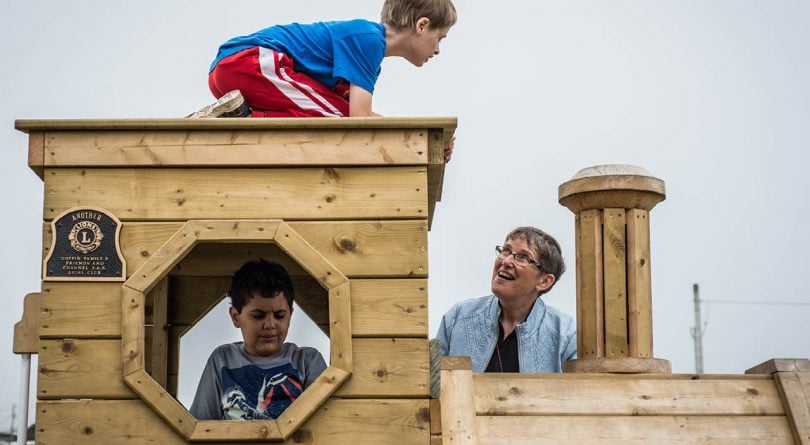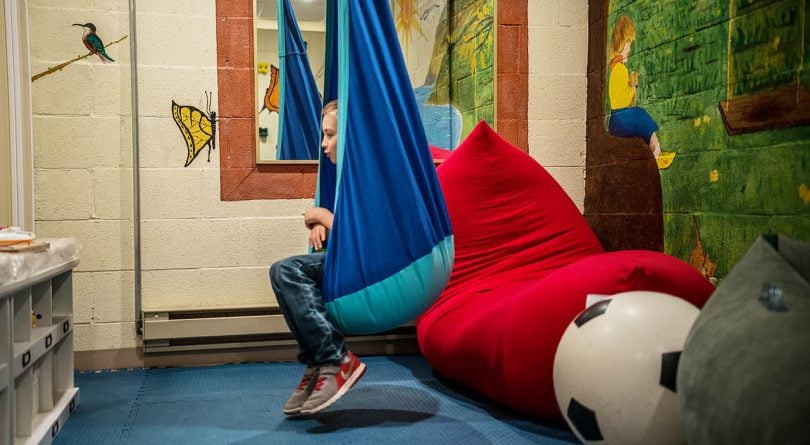The most autism-friendly town in Canada
How two women transformed their tiny Newfoundland community from a zero-resources town to the best place in the country to raise kids on the spectrum

“My husband e-mailed me an article that said there was evidence in autism research that showed early intervention could actually change the child’s brain. I responded ‘You know, I think we did this. We changed Isaac’s brain.’”— Candace Matthews (Photograph by Carla Antonio)
Share
The human brain takes in information about the world through all of the senses and filters it as required. But imagine if all the information you took in from a simple walk down the street was coming at you all at once, as it does for a child with autism spectrum disorder (ASD). The noise of passing cars, chirping birds and people talking would be like having three radios tuned into different stations at once, turned up so loudly that all you’d want to do is hold your hands over your ears. Throw in a police siren and you might want to run away. If you’re nonverbal and not able to tell anybody what you need or feel or think—you might even want to rock or scream or bang your head.
Autism is a developmental disorder on a spectrum, and every child has his or her own unique pattern and severity of symptoms. Some kids can practically blend in with classmates in a regular school, while others will need caregivers to look after them into their adult lives. It’s always a puzzle, and it’s always a challenge. It’s hard for the parents of kids with ASD, too: All they want is for their children to feel accepted and be happy. Through an amazing grassroots initiative that has captured the imagination of a whole town, Channel-Port aux Basques, Newfoundland, has become a place where that’s not only possible but also normal.
In many ways, Channel-Port aux Basques is a typical Newfoundland town: It’s a place where passing strangers say hello and where drivers slow down and smile so that pedestrians can jaywalk at their leisure. Newfoundlanders are known for being friendly, but the people of Channel-Port aux Basques have taken human kindness to a whole new level. Without huge funds and costly equipment, it has become a town where it’s a little easier to live life on the spectrum.
Over six years, Channel-Port aux Basques has gone from having zero local resources to becoming the first autism-friendly town in Canada. In the summer of 2017, mayor Todd Strickland made it official with a pen flourish at a declaration signing at the town hall.
It all began with two local women who wouldn’t take no for an answer.
The Public Health Agency of Canada estimates that autism spectrum disorder (ASD) affects one in 66 children between the ages of five and 17 in Canada. Numbers are most prevalent in Newfoundland at one in 57 children. (Of the 300 kids in Channel-Port aux Basque’s elementary school, 14 have been diagnosed with ASD.) As yet, nobody knows why.
This town of 3,665 is the gateway to Newfoundland and Labrador from mainland Canada—a seven-hour sail from Cape Breton Island. Up until six years ago, there was nothing here for families with kids on the spectrum. Parents of kids with ASD felt incredibly isolated. If you wanted to join a support group or access basic resources for your child, it was a two-and-a-half-hour drive to the nearest city, Cornerbrook.

But that all changed just months after April Billard’s son, William, was diagnosed with ASD in 2010. Billard grew up in Isle aux Morts, a 15-minute drive from Channel-Port aux Basques, where she lives now with her husband and two kids, William, 10, and Gina, 7, who also has autism. Billard vividly remembers the moment when William was diagnosed. Even though he was the same child she knew and loved, everything suddenly seemed different. Instinctively, she’d known a diagnosis was coming because of his speech delays, lack of eye contact and fussiness when touched. Still, she didn’t know much about autism and cried in the car the whole way home from St. John’s. Desperate for guidance, she turned to Joan Chaisson, a newly retired special-education teacher.
Back then, Chaisson was filling her days with a college course for fun and walks all over town as part of a self-imposed fitness regimen. After 30 years of teaching, retirement was a hard adjustment, and she was toying with the idea of setting up a consultancy business for parents. But when the Billards approached her, she realized that she didn’t feel like asking for money from people who had just had their whole lives turned upside down by a diagnosis. “I couldn’t walk past your house two or three times a day and know you have a child in there who needs help,” she told the couple. “I’ll do it.”
William became Chaisson’s first coaching client in 2011, and Billard and Chaisson became fast friends. A year later, after venting together in Billard’s kitchen, they decided to take the dire situation for local families dealing with children with ASD into their own hands. They decided to make Channel-Port aux Basques into the type of town they dreamed of living in—a place where parents felt supported and kids with ASD could participate in life to the fullest. They co-founded a community group, Autism Involves Me (AIM), and created a remarkable model of inclusion that’s so simple and low-budget to implement that every small town across Canada should be sitting up and taking notes.

AIM started out as a parents’ support group, with seven or eight members. They would talk about challenges and get their kids together to play in a family room filled with sensory toys. They built a library of specialized parenting books and resources and started think about what else they could do to make life richer outside of that safe bubble.
The vision of AIM was to have autism services and support integrated into the fabric of their hometown rather than siloed as special-needs offerings. “It’s not that the town wouldn’t do it before,” says Chaisson. “It was just that no one really knew what we could do.”
Since working with William, Chaisson has moved on to work with several local kids who have ASD and help them rehearse life skills out in the community. She breaks down each activity (such as going to the post office and ordering at a restaurant) into steps. But before she does that, she goes into a business to prepare staff about the child she is bringing in, along with their abilities, challenges and specific goal for the day.
For instance, if a child is struggling with going to loud restaurants, Chaisson might encourage the child to just walk through the door so he can see what it looks like. She’ll drop off cue cards so that the staff can ask the child simple questions that he can understand. She might also share a few details about a child’s biggest passion (such as dinosaurs and trains) so that the server can throw in a question about that and help him feel comfortable and develop his social skills. The next step is to get the child to sit in a booth without wanting to make a dash for the door. When that feels comfortable, the child will order from the menu, just as he practised in run-throughs with Chaisson at home.
Chaisson has a way of making people feel inspired and excited about the small changes they can implement to accommodate and welcome families affected by autism. And her outings have a ripple effect: Within months, AIM evolved from a low-key support group into a movement with a life of its own. (It now has 63 members.) What surprised the founders most was how local people who didn’t even have kids on the spectrum wanted to lend their support. Kris’ Kustoms auto body shop organized a vintage car show to raise funds to equip the AIM room with more specialized equipment. Cory Munden, chief executive officer of Leading Edge Credit Union, printed off resource materials for parents. Cindy Goudie LaPolla, owner of The Medicine Shoppe Pharmacy, paid to have informational texts about autism printed in the local newspaper, The Gulf News, each week. And it snowballed from there.
When Chaisson drops into Channel-Port aux Basque’s only barbershop with Elyas, an 11-year-old that she is coaching, barber Edgar Allan recalls the first time he cut the boy’s curls three years ago. “When I say he needed a haircut, I mean he needed a haircut,” he says. On Elyas’s first visit, Allan had to follow him around the barbershop quietly for a good hour, trying to coax the nervous child to submit to the clippers. But three years after that first cut, Elyas knows and trusts Allan. The barber has good instincts to talk in a soft and soothing voice. And as Chaisson recommended, he always shows kids with autism the instrument he is about to use and softly talks them through the next step so that the vibration of clippers or the sensation of gel on the scalp won’t come as a shock to a child with sensory sensitivities.
On this visit, after barely 20 minutes in the chair, Elyas is giggling as Allan blows stray clippings off his neck with an old-fashioned hairdryer. “You see how calm he is now?” says the barber, as he offers the boy a lollipop for each hand.

What Allan does in his barbershop isn’t ground-breaking, but little changes can make a huge difference for kids with ASD. As Billard says, “When you’re the mom of a child with autism, it’s just so easy to think that nobody will ever have your back. But when you have people in your community who are willing to learn, it means a lot.”
In any coastal town, where life revolves around boats and beaches, every child should learn how to swim. For kids with ASD, it’s vital. “Children who are on the autism spectrum are drawn to water,” says Wanda Merrigan, the aquatic supervisor at the Bruce II Sports Centre. A recent report from Columbia University states that drowning is the number one cause of accidental death for kids with ASD in the United States. To put a sobering number on it, 91 percent of accidental deaths happen this way for this demographic.
For children with ASD, group swimming lessons can feel like an assault on the senses. There’s the noise of voices bouncing off concrete walls, the fear of getting splashed by surprise, instructors yelling out multistep instructions and lifeguards blowing whistles. After Chaisson and the AIM group came to chat with the team about how they could do things differently, they decided to offer one-on-one classes for kids on the spectrum. Wanda handpicked three swimming instructors she knew she could count on to be patient and flexible.
Typically, swimming teachers check off boxes as the kids in their regular classes learn new skills in a set order. But for these private lessons, Chaisson came in and taught the young teachers to take their cues from the kids. The children might spend the first nine lessons simply wading in the shallow end. Then, on week 10, all of a sudden they’ll want to venture out of their depth with a flotation device, maybe even try to doggy-paddle. “It’s always a good day when a child learns to swim,” says Merrigan, “and the days when children on the spectrum do it are doubly exciting—everybody cheers.”
As one of the group’s special swimming instructors, 16-year-old Chloe Munden felt empowered by what she learned. “It has made me a more understanding person,” she says. “I’m really proud that I can help people reach their goals.”
Kids with autism also come to the Bruce II for the full gamut of fitness activities. They use the centre’s bowling alley during off-peak hours for “Sunshine Bowling” sessions. Staff bring down a small trampoline for the kids to bounce on between turns to help them work out their anxiety and develop patience. In partnership with AIM, the sports centre now has a mini-gym full of sensory-play equipment, including “the squeeze machine,” a piece of apparatus with giant foam rollers that kids can roll their entire bodies through. It provides a soothing sensation for many kids with ASD and is just plain fun for all the town’s preschoolers, who also benefit from the cool new apparatus during open sessions.
AIM parents came into the Bruce II to talk with the sports camp counsellors about how to help their kids join in and how to spot the signs they needed to sit in a quiet space and regroup. “Kids with autism shouldn’t have to feel different,” says Keira Francis, a soft-spoken 18-year-old who is the camp’s designated student counsellor for children with autism. “They should just get to have normal lives.”

“I love this place,” says Isaac, a 10-year-old child on the spectrum who has grown up in Channel-Port aux Basques. He is on a boat tour with local lobster fishermen, zipping past the ferry port, white-steepled church and boardwalk of Channel-Port aux Basques, with its rainbow flags and murals of fishwives salting cod. Isaac especially loves Cheeseman’s Beach (“The orange flowers there look like the fire flowers in Mario!”) and is fascinated by the region’s geology (“I have a rock collection of 48!”). But his favourite place in town is the sensory room that opened at Hotel Port aux Basques in 2017.
Isaac is a freckle-nosed child whose eyebrows dance as he talks a mile a minute and whose last milk tooth clings on by a thread behind a set of adult teeth that he is still growing into. “It’s been like that for a year and he won’t just yank it out,” says his mother, Candace Matthews, as she follows him into the sensory room, a repurposed staff gym full of calming toys and books and sensory equipment, all bought in consultation with the AIM group.
Isaac has a turn on the climbing wall, runs his hand through a box of giant pasta noodles and makes for the crow’s nest, a swing chair with canvas sides that hangs from the ceiling. He gets inside and pulls the fabric sides shut, then half-closes his eyes, smiles contentedly and swings in gentle circles. His vocal tic—a near-constant whirring in the throat—is no longer perceptible, and he looks visibly serene. “I feel like I’m cocooned in here, just squeezing in and turning into a butterfly,” he says.
Last year, Chaisson approached Cathy Lomond, the hotel’s owner, to suggest that she make the hotel autism-friendly for local kids and travellers. A folk and rock singer in her spare time, the hotelier has a sister in her 50s with Down syndrome and needed no convincing to take up the cause of inclusion. She ended up making so many changes for ASD families that Hotel Port aux Basques was dubbed “Canada’s first autism-friendly hotel” in national print and TV media, and the phone ran off the hook with bookings.
“The media kind of took us by surprise,” says Lomond. “The picture of our sensory room published in our local paper went not just through Canada but right across North America—it spread like wildfire.” Then came kudos from around the world on social media. “We had Twitter messages from Russia and Australia,” she says.
In addition to the sensory room, Lomond also made a digital slideshow about her hotel to help kids with ASD cope with the unfamiliar. The photos walk children through every step they’ll take, from the lobby to their room, from the sensory room to the restaurant. She created picture menus for the dining room so that non-verbal kids could point to their meals of choice. (The kitchen will also make special meals to accommodate dietary restrictions and recreate favourite dishes from home.)
“The biggest issue when you’re travelling with a child with autism is safety,” says Lomond. After consulting with local parents, she adapted some of the rooms, put child locks on drawers and secured anything movable, such as coffee makers, televisions and pictures on the wall, in case of accidents and meltdowns. Lomond added safety locks high up on the doors to keep in children who were prone to wandering—an issue for 50 percent of kids on the spectrum. “The changes weren’t difficult or expensive to do,” she says. “I’d encourage any hotel to do it.”
The Autism Society of Newfoundland and Labrador (ASNL) came in to train hotel staff. “When word got around town that we were doing autism sensitivity training, other businesses asked if they could send employees, so we opened up the hotel and did a second session for workers from across the whole town,” says Lomond. “In most small communities, you have activities for the mainstream,” she adds. “It really makes me proud that our community has gone out of its way to accommodate children on the autism spectrum.”
As Isaac prepares to leave his beloved sensory room, he makes an announcement. “This hotel deserves to be treated to more than three-and-a-half stars,” he says, striding through the lobby. “Maybe four-and-a-half stars?” he adds. “And if they had a swimming pool, maybe even five.”
Once everyday situations were taken care of, the AIM group turned their focus to emergency situations. Last May, they had a speaker from ASNL give a presentation on autism and safety to local first responders.
A house fire is a worst-case scenario for a child with ASD. “You have the fire roaring, firefighters hauling hoses and people running back and forth, crying and screaming,” says Billard. It’s hard to think of anything more overwhelming for a child who is hypersensitive to noises, lights and smells, hates changes to their routine and may even be non-verbal or unable to use his words under stress. How is a first responder with adrenaline pumping supposed to help him if he has lost control or shut down?
After the safety talk, an AIM parent took the initiative to get every fire truck in Channel-Port aux Basques equipped with “sensory bins” whose contents have been carefully curated to console, distract and de-escalate an autistic child in distress. There’s a checklist of tips on the lid to remind firefighters how to assist a child on the spectrum: “Speak calmly, use short sentences and be patient answering the same questions over and over.”
As Billard stocks these boxes at the fire station, fire chief Jerry Musseau sits in a shiny red fire truck with Christopher, a wispy-haired seven-year-old with ASD. Christopher and his mother, Joanie Shepherd, moved to Channel-Port aux Basques two years ago so that they could take advantages of all the ASD services and support. Christopher is visibly excited to be in the vehicle: He tries out the steering wheel, stares at the dashboard and rifles through the sensory bin on board before putting on the noise-cancelling headphones, rattling an egg shaker and loudly declaring he can’t hear a thing. “That’s right, Christopher,” says Musseau, with a smile and an even tone.
Up until the workshop last year, Musseau didn’t know much about how ASD affected kids. “I didn’t realize that sirens and flashing lights could be traumatic to these kids,” says Musseau. “None of us first responders did.”
Since talking with AIM parents, the fire department has also created a quiet zone where kids with autism can watch their annual Christmas parade. There are no lights and sirens on this designated stretch. “These kids should have the right to watch the parade like everybody else,” says Musseau.
“These kids should have the right, like everybody else” has almost become a town motto, and it’s all thanks to AIM and the willingness of ordinary citizens to listen and step up.
“You don’t have to throw millions of dollars at a program,” says Matthews. “You don’t have to build anything. All you have to do is open your mind and ask questions. Be open to making small changes and accommodations. I would never consider leaving Port aux Basque now. It’s just golden—you wouldn’t believe it.”